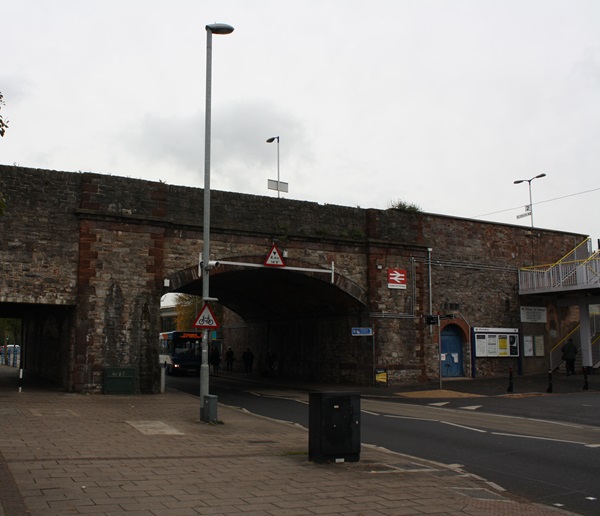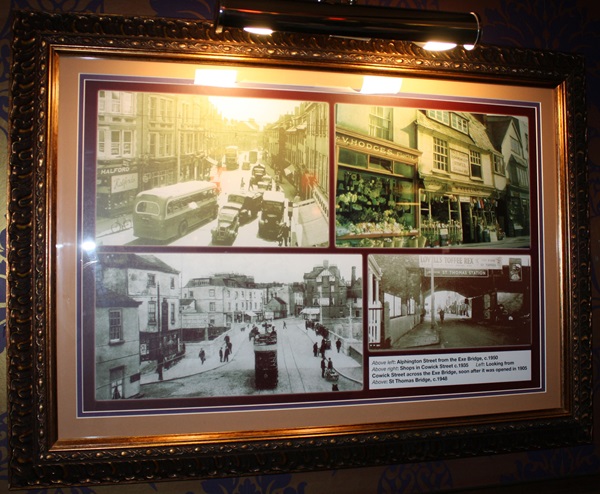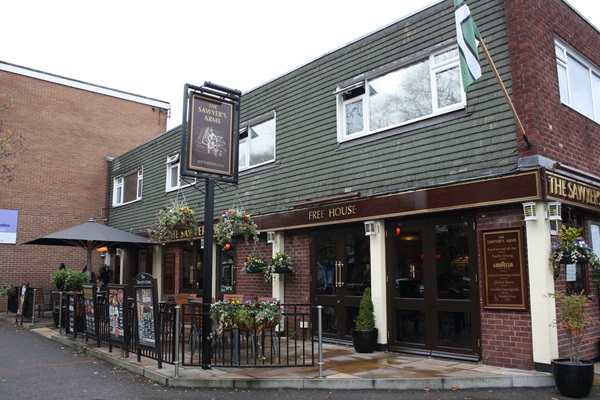This public house is located in the suburb of St Thomas, not far from the city centre. Built in 1966, this detached building occupies a large plot on the corner of Cowick Street and Prospect Place, apparently decorated internally ‘with circular saws and saw-teeth motifs’. This replaced an earlier public house called Sawyer’s Arms, first recorded in White’s Devon Directory of 1850, run by John Gibbs.
Framed drawings and text about Grace Darling. Grace and her father rescued all survivors from the wreck of SS Forfarshire.

The text reads: There is a memorial in St Thomas’ churchyard to the Northumbrian lifeboat heroine, Grace Darling. Grace spent her youth in two lighthouses, where her father was the keeper. In the early hours of 7 September 1838, Grace spotted the wreck of the SS Forfarshire on a nearby rocky island. The weather was too rough for the lifeboat to put out so Grace and her father took to the rowing boat. In two trips they rescued all the survivors. The weather was so bad that everyone had to stay at the lighthouse for three days.
Grace Darling died of tuberculosis in 1842, aged 26. She is buried with her father and mother in St. Aidan’s churchyard, Bamburgh.
Above right: Grace Darling 1838
Above left: Grace and her father rowing to the wreck of the Forfarshire
Right: Grace, the Victorian heroine.
Framed drawings and text about Cowick Street.

The text reads: Cowick Street has long been an important route into Exeter from the west. In 1947 Perkin Warbeck marched along Cowick Street in an attempt to gain the throne from Henry VII.
Warbeck claimed to be the Duke of York and rightful King rather than Henry the Tudor upstart. Charles VIII of France welcomed him to Paris in 1492 where supporters of the House of York gathered around him. From Paris he moved to Flanders where Margaret of Burgundy, Edward IV’s sister, took him in as her nephew. Margaret funded Warbeck’s first failed invasion in 1495. The march on Exeter was his second attempt. His 6,000 strong Cornish army burned down the North Gate and the East Gate was breached. However, the rebels suffered heavy losses and lost heart. Warbeck was captured. He next entered Exeter a prisoner of the King, and was hanged at Tyburn in 1499.
Above left: Perkin Warbeck, c.1560
Centre: Henry VII
Right: above, Charles VIII, King of France below, Margaret of Burgundy.
A framed photograph and text about the history of the building and of the original Sawyer’s Arms, 1850.

The text reads: This building has been a local landmark since 1966. However, The Sawyer’s Arms is actually much older. The present public house replaced an earlier pub of the same name, sited nearer to the River Exe, (at 114 Cowick Street). The original Sawyer’s Arms was first recorded in White’s Deveon Directory, of 1850. By 1911 it was in the hands of the City Brewery and had its own Brewhouse at the rear of the premises. The old pub was demolished in 1957.
Framed drawings and text about The Veitch family.

The text reads: When the Veitch Nursery in Alphington closed in 1975, an era, that began when James Veitch was brought from Scotland by Sir Thomas Acland to improve the grounds of his Killerton estate in 1808, came to an end. The Veitch family went on to run perhaps the most important Nursery firm the world had ever known. The nurseries were most famous for their orchids, but plants, shrubs and trees were introduced to Britain from all the temperate regions of the world.
Sir Harry J Veitch (1840-1924) was born in Exeter and educated at the Exeter Grammar School. He was knighted by King George V in 1912 for his contribution to horticulture and his part in establishing the first Chelsea Flower Show in 1906.
The Alphington Nursery opened in 1929, when Mildred Veitch became Managing Director.
Left: Disa Veitchii, the famous Veitch hybrid orchid, first flowered in 1891
Above centre: Cattleya x dominana, raised in Exeter in 1850
Right (above and below): Sir Harry Veitch.
Framed photographs and text about bridges in Exeter.

The text reads: The first stone bridge over the Exe, built by the mayor, Walter Gervase, in the 13th century, was replaced in 1788. The second stone bridge lasted until 1903, when it made way for something more up-to-date in the form of a steel arch structure, designed by Sir John Wolfe Barry, who is better known as the designer of Tower Bridge in London. Work began on the present bridge in 1968, and it was opened in July 1969.
Above: The second stone bridge, just before its demolition.
Left: The official opening of the steel bridge in 1905.
The St Thomas railway bridge today, located down the road from The Sawyer's Arms.

A framed collage of photographs of the area in the 19th century.

The text reads:
Above left: Alphington Street from the Exe Bridge, c.1950
Above right: Shops in Cowick Street c.1935
Left: Looking from Cowick Street across the Exe Bridge, soon after it was opened in 1905
Above: St Thomas Bridge, c1948.
External photograph of the building – main entrance.

If you have information on the history of this pub, then we’d like you to share it with us. Please e-mail all information to: pubhistories@jdwetherspoon.co.uk